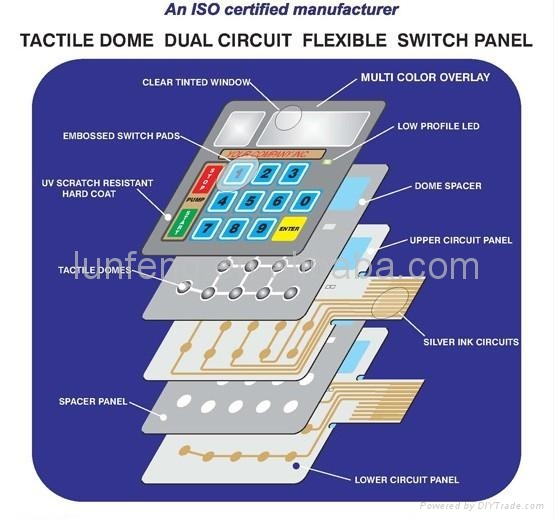Membrane Switch: A Comprehensive Guide to Its Uses and Applications
Membrane Switch: A Comprehensive Guide to Its Uses and Applications
Blog Article
Understanding Membrane Switches Over: The Secret to Dependable and sturdy Controls

What Are Membrane Buttons?
Membrane buttons are a sophisticated service in the realm of individual interface innovation, incorporating functionality and style seamlessly. These tools work as an interface between customers and digital systems, integrating numerous components into a compact format. Typically created from flexible, slim layers of materials, membrane layer switches are developed to react to touch, allowing individuals to engage with machinery and digital gadgets efficiently.
The primary components of a membrane button consist of a published circuit layer, graphic overlay, and a spacer layer that avoids unintended activation. The visuals overlay can be customized to mirror brand identity or individual preferences, enhancing appearances while making sure use. Membrane layer buttons are commonly used in different applications, consisting of clinical devices, consumer electronic devices, and commercial equipment, owing to their longevity and resistance to environmental variables such as moisture and dirt.
One of the essential benefits of membrane layer buttons is their capacity to hold up against deterioration, making them ideal for high-traffic environments. Additionally, they are light-weight and call for marginal space, enabling cutting-edge styles in product growth. On the whole, membrane switches represent a sensible and efficient choice for modern electronic interfaces, marrying modern technology with user-centric layout principles.
How Membrane Layer Switches Job
The procedure of membrane switches over joints on a straightforward yet effective mechanism that converts individual input right into electronic signals. These buttons consist of multiple layers, usually including a graphic overlay, a spacer layer, and a circuit layer. When a customer presses the button, the top layer deforms, allowing a conductive component in the circuit layer to make contact with an equivalent conductive pad on the bottom of the visuals overlay. This contact shuts the circuit and sends out a digital signal to the gadget, showing that the switch has actually been activated.
The style of membrane layer switches can differ, but they frequently incorporate domes or tactile components to supply feedback to the individual, improving the general experience - membrane switch. The products made use of in membrane layer switches, such as polyester or polycarbonate, add to their toughness and resistance to environmental elements, including dampness and dust. The published circuits are normally enveloped, which secures them from wear and tear over time.
Benefits of Membrane Layer Buttons

Additionally, membrane layer switches are known for their longevity. Constructed from durable materials, they are resistant to dust, wetness, and physical wear, which considerably expands their life expectancy contrasted to conventional mechanical switches. This toughness makes them particularly suitable for high-traffic environments and applications calling for longevity.
Another significant advantage is the ease of cleansing and upkeep. The smooth surface of membrane layer changes lessens dirt accumulation and is usually impervious to spills, making them excellent for settings that need regular sanitization.
Additionally, membrane buttons provide a structured account, causing a thinner design that can be incorporated into various gadgets without including bulk. This feature not just improves the visual allure yet likewise adds to a much more ergonomic item layout.
Applications of Membrane Buttons
Versatile and straightforward, membrane buttons find applications throughout a vast range of sectors, consisting of clinical gadgets, consumer electronics, and commercial equipment. In the clinical area, these find out here now buttons are indispensable to gadgets such as diagnostic tools, client surveillance systems, and infusion pumps, where reliability and simplicity of cleaning are vital. Their capability to hold up against extreme environments and keep functionality makes them excellent for such applications.

In consumer electronic devices, membrane switches are utilized in items like microwaves, cleaning makers, and remote controls - membrane switch. Their smooth design permits user-friendly user interfaces, improving the general user experience while giving sturdiness and resistance to deterioration
Commercial tools likewise gains from membrane layer switches, especially in control panels for equipment and automation systems. These switches provide protection against dust and moisture, making certain constant efficiency in challenging atmospheres. In addition, their adjustable functions allow makers to tailor them to specific functional demands, improving performance and performance.
Selecting the Right Membrane Layer Change
When choosing a membrane layer switch, it is vital to take into consideration numerous variables that influence performance and viability for details applications. The main considerations include environmental conditions, responsive feedback, resilience, and design requirements.
First, assess the operating setting; switches subjected to moisture, chemicals, or severe temperature levels require details products to guarantee long life and functionality. Next off, assess the demand for responsive feedback. Depending upon customer interaction, some applications might take advantage of a responsive response to validate activation, while others may favor a non-tactile design for aesthetic factors.
Resilience is another vital variable; membrane buttons must be made to endure regular use, impacts, and abrasion. Make sure the picked button can sustain the anticipated lifecycle, especially in high-usage situations.

Final Thought
In verdict, membrane switches over offer as vital parts in the style of long lasting and dependable control systems throughout different markets. The adaptability of membrane switches permits for tailored solutions that meet specific functional needs, reinforcing their importance in contemporary technology.
Membrane switches represent an essential element of modern interface design, mixing performance with durability in various applications.Membrane layer switches are an advanced solution in the world of customer interface technology, integrating performance and design seamlessly. Normally constructed from adaptable, slim layers of materials, membrane layer buttons are designed to respond to touch, enabling individuals to interact with equipment and digital tools successfully.
The style of membrane layer buttons my explanation can vary, but they usually integrate domes or tactile elements to offer responses to the customer, improving the overall experience.In conclusion, membrane switches serve as necessary parts in the design of trusted and durable this page control systems throughout numerous markets.
Report this page